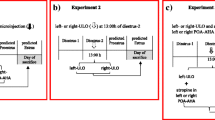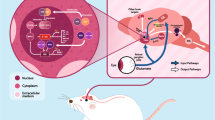The involvement of the central monoaminergic systems in regulation of the gonadotropic function of the hypophysis is not, at present, in question. At the same time, the question of whether catecholamines influence only the release of luliberin by neurons of the median eminence (ME) or these agents affect simultaneously other structures of the preoptico-tubero-infundibular luliberin-producing system remains open. In experiments with recording of an evoked increase (surge) in the level of gonadotropins in ovariectomized rats that received sex steroids, we studied the effects of some agonists and antagonists of catecholamines on the amount of luliberin in the mediopreoptic region (MPR), arcuate nucleus (ANs), and ME of the hypothalamus, as well as on the levels of luteinizing and follicle-stimulating hormones (LH and FSH, respectively) in the blood. Important fundamental differences in modulation of the evoked surge of hypophyseal gonadotropins under the action of a few pharmacological agents (agonists and antagonists of catecholamines) were observed. Noradrenergic influences on the preoptic region play a dominant role in the control of cyclic release of LH, while the release of FSH is regulated by influences coming from the dopaminergic system.
Similar content being viewed by others
References
1. P. Atkinson, J. Koch, D. Susic, and W. L. Ledger, “GnRH agonist triggers and their use in assisted reproductive technology: the past, the present and the future,” Women’s Health, 10, No. 3, 267-276 (2014).
J. M. Guzmán, R. Cal, A. García-López, et al., “Effects of in vivo treatment with the dopamine antagonist pimozide and gonadotropin-releasing hormone agonist (GnRHa) on the reproductive axis of Senegalese sole (Solea senegalensis),” Comp. Biochem. Physiol. Mol. Integrat. Physiol., 158, No. 2, 235-245 (2011).
A. N. Hirshfield and L. V. De Paolo, “Effect of suppression of the surge of follicle-stimulating hormone with porcine follicular fluid on follicular development in the rat,” J. Endocrinol., 88, No. 1, 67-71 (1981).
A. Maheshwari, A. Gibreel, C. S. Siristatidis, and S. Bhattacharya, “Gonadotrophin-releasing hormone agonist protocols for pituitary suppression in assisted reproduction,” Cochrane Database Syst. Rev., 10, No. 8, CD006919 (2011).
A. C. van Loenen, J. A. Huirne, R. Schats, et al., “GnRH agonists, antagonists, and assisted conception,” Semin. Reprod. Med., 20, No. 4, 349-364 (2002).
A. T. Viveiros, A. C. Gonçalves, I. M. Di Chiacchio, et al., “Gamete quality of streaked prochilod Prochilodus lineatus (Characiformes) after GnRHa and dopamine antagonist treatment,” Zygote, 18, 1-10 (2013).
Author information
Authors and Affiliations
Corresponding authors
Rights and permissions
About this article
Cite this article
Boukia, N.G., Butskhrikidze, M.P. & Svanidze, M.D. Catecholaminergic Regulation of the Production of Gonadotropins in Female Rats. Neurophysiology 47, 386–390 (2015). https://doi.org/10.1007/s11062-016-9546-1
Received:
Published:
Issue Date:
DOI: https://doi.org/10.1007/s11062-016-9546-1




